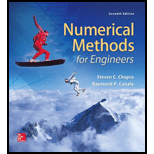
The following system of equations is designed to determine concentrations
(a) Determine the matrix inverse.
(b) Use the inverse to determine the solution.
(c) Determine how much the rate of mass input to reactor 3 must be increased to induce a
(d) How much will the concentration in reactor 3 be reduced if the rate of mass input to reactors 1 and 2 is reduced by 500 and 250 g/day, respectively?
(a)
To calculate: The inverse for the given system:
Answer to Problem 8P
Solution:
The inverse matrix is,
Explanation of Solution
Given:
The system of equations,
Formula used:
(1) The forward substitution equations for L can be expressed as,
(2) The backward substitution equation for U can be expressed as,
(3)
Calculation:
Consider the system of equations,
The coefficient
And subtracting the result from equation (2).
Thus, multiply equation (1) by
Now subtract this equation from equation (2),
The coefficient
And subtracting the result from equation (3).
Thus, multiply equation (1) by
Now subtract this equation from equation (3),
Now the set of equations is,
The factors
The coefficient
And subtracting the result from equation (5).
Thus, multiply equation (4) by
Now, subtract this equation from equation (5),
The factor
Thus, the matrix obtained is:
Therefore, the LU decomposition is
Now, to find the inverse of the given system.
The first column of the inverse matrix can be determined by performing the forward substitution solution with a unit vector (with 1 in the first row) of right-hand-side vector.
The forward substitution equations for L can be expressed as,
Where,
Determine [D] by substituting L and B as shown below,
Solve for
Solve for
Solve for
Hence, the values obtained are
Solve with forward substitution of
This vector can be used as right-hand side vector of equation,
Solve the above matrix by back substitution, which gives the first column of the inverse matrix as:
Similarly, the second column of the inverse matrix can be determined by performing the forward substitution solution with a unit vector (with 1 in the second row) of right-hand-side vector.
The forward substitution equations for L can be expressed as,
Where,
Determine[D] by substituting L and B as shown below,
Solve for
Solve for
Solve for
Hence, the values obtained are
Solve with forward substitution of
This vector can be used as right-hand side vector of equation,
Solve the above matrix by back substitution, which gives the second column of the inverse matrix as:
Similarly, the third column of the inverse matrix can be determined by performing the forward substitution solution with a unit vector (with 1 in the third row) of right-hand-side vector.
The forward substitution equations for L can be expressed as,
Where,
Determine [D] by substituting L and B as shown below,
Solve for
Solve for
Solve for
Hence, the values obtained are
Solve with forward substitution of
This vector can be used as right-hand side vector of equation,
Solve the above matrix by back substitution, which gives the third column of the inverse matrix as:
Thus, the inverse matrix is:
(b)
To calculate: The solution of the given system using inverse:
Answer to Problem 8P
Solution:
The solution of the given system is
Explanation of Solution
Given:
The system of equations,
Where,
Formula used:
If
Calculation:
Consider the given system of equations:
Where,
The inverse of the given system is:
Thus, the solution vector [C] is given by:
Thus, the solution of the given system is
(c)
To calculate: The rate of mass input to reactor 3 that is to be increased to induce a
Answer to Problem 8P
Solution:
The rate of mass input must be increased to
Explanation of Solution
Given:
The system of equations,
And the inverse of the given system is:
Formula used:
Calculation:
Consider the given system of equations:
Where,
Let rate of mass input to reactor 3 be
Rise in concentration of reactor 1 be
The inverse of the given system is:
So,
Thus,
Hence, the rate of mass input must be increased to
(d)
To calculate: The reduced concentration in reactor 3 if the rate of mass input to reactors 1 and 2 is reduced by 500 and 250 g/day, where the following system of equations is designed to determine concentrations
Answer to Problem 8P
Solution:
The reduced concentration in reactor 3 is
Explanation of Solution
Given:
The system of equations,
And the inverse of the given system is:
Formula used:
Calculation:
Consider the given system of equations:
Where,
Let, the reduced concentration of reactor 3 is
The reduced rate of mass input to reactor 1 is
The reduced rate of mass input to reactor 2 is
The inverse of the given system is:
So,
Thus,
Hence, the reduced concentration in reactor 3 is
Want to see more full solutions like this?
Chapter 10 Solutions
Numerical Methods for Engineers
Additional Math Textbook Solutions
Advanced Engineering Mathematics
Basic Technical Mathematics
Fundamentals of Differential Equations (9th Edition)
Finite Mathematics (11th Edition)
Pre-Algebra Student Edition
 Linear Algebra: A Modern IntroductionAlgebraISBN:9781285463247Author:David PoolePublisher:Cengage Learning
Linear Algebra: A Modern IntroductionAlgebraISBN:9781285463247Author:David PoolePublisher:Cengage Learning Elementary Linear Algebra (MindTap Course List)AlgebraISBN:9781305658004Author:Ron LarsonPublisher:Cengage Learning
Elementary Linear Algebra (MindTap Course List)AlgebraISBN:9781305658004Author:Ron LarsonPublisher:Cengage Learning Algebra for College StudentsAlgebraISBN:9781285195780Author:Jerome E. Kaufmann, Karen L. SchwittersPublisher:Cengage Learning
Algebra for College StudentsAlgebraISBN:9781285195780Author:Jerome E. Kaufmann, Karen L. SchwittersPublisher:Cengage Learning


